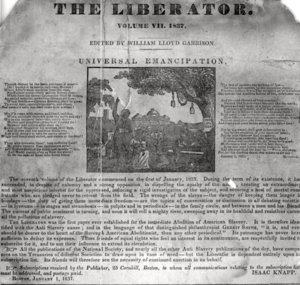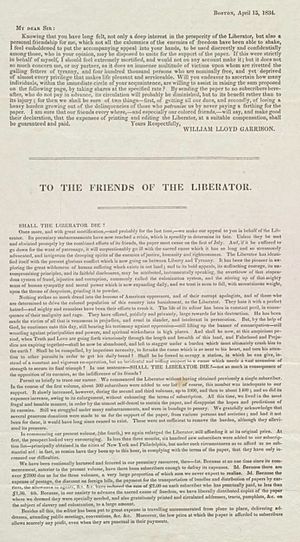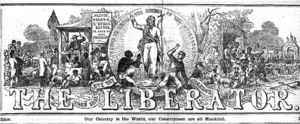The Liberator (newspaper) facts for kids

Liberator v.1, No.1, 1831
|
|
| Type | Weekly newspaper |
|---|---|
| Publisher | William Lloyd Garrison and Isaac Knapp |
| Founded | January 1, 1831 |
| Ceased publication | December 29, 1865 |
| City | Boston |
| Country | United States |
| OCLC number | 1728160 |
The Liberator was a weekly newspaper published from 1831 to 1865. It was printed in Boston by William Lloyd Garrison and Isaac Knapp. This newspaper was a strong voice against slavery, also known as an abolitionist paper. It encouraged people to free enslaved people right away, a belief called "immediatism."
The Liberator also supported women's rights. This topic actually caused some disagreements within the abolitionist movement. Even though it only had about 3,000 readers, many important people read it. These included Frederick Douglass, Beriah Green, and Alfred Niger. The newspaper often shared letters, reports, and news about slavery. It became like a community message board for the growing anti-slavery movement.
Contents
About The Liberator Newspaper
William Lloyd Garrison published The Liberator every week for 35 years. It started on January 1, 1831, and the last issue was on December 29, 1865. The newspaper was known across the country for its strong message. It demanded the "immediate and complete emancipation of all slaves" in the United States.
In the very first issue, Garrison wrote a famous letter called "To the Public." He made it clear that he would not be quiet about slavery. He wrote that he would be "as harsh as truth, and as uncompromising as justice." He believed that slavery was a terrible wrong. He refused to use "moderation" when talking about it.
Garrison wanted to change people's minds using peaceful methods. He used "moral suasion," which means convincing people by appealing to their sense of right and wrong. He felt that slavery was a moral problem. He hoped his writing would make readers see how wrong slavery was. For example, the slogan "No Union with Slave-Holders" was often used. This slogan suggested that the Northern states should separate from the Southern states that allowed slavery.
The Liberator continued to be published throughout the American Civil War. It even had Black writers and reporters. Garrison stopped publishing the newspaper at the end of 1865. This was after the Thirteenth Amendment was approved. This amendment officially ended slavery everywhere in the United States.
Standing Up for Women's Rights
The Liberator also became a newspaper that strongly supported women's rights. In 1838, the paper announced its goal was to "redeem woman as well as man from a servile to an equal condition." This meant it would support women's rights as much as possible.
In early 1838, the newspaper published "Letters on the Province of Woman" by Sarah Grimké. Later, these letters were made into a book. This helped bring attention to another project by Garrison and Knapp, the Boston Female Anti-Slavery Society. For many years, The Liberator promoted women's rights. It published articles, petitions, and speeches. It also shared news about women's right to vote, equal property rights, and equal opportunities in education and jobs.
Inspiring Others
The Liberator inspired many people to join the anti-slavery movement. One example is Angelina Grimké. She was from a wealthy family that owned enslaved people. After reading The Liberator, she decided to speak out against slavery. Her letter to William Lloyd Garrison was published in the newspaper.
Frederick Douglass was also inspired by The Liberator. He felt it was important for African Americans to share their own experiences with unfairness. He believed that those who faced injustice should be the ones to demand justice. Soon after, Douglass started his own anti-slavery newspaper, The North Star.
In 1836, Alfred Niger became an agent for The Liberator in Rhode Island. Five years later, he helped start the Rhode Island Anti-Slavery Society. He was one of only two Black men in the entire organization.
Facing Challenges
The Liberator faced a lot of opposition. Some state governments and local groups strongly resisted it. For example, North Carolina accused Garrison of serious crimes. A group in Columbia, South Carolina, even offered a reward of $1,500 to anyone who could identify people distributing the newspaper.
Garrison himself faced danger and violence. In 1835, a mob formed in Boston. Local newspapers supported the mob. They were angry because George Thompson was going to speak at a meeting of the Boston Female Anti-Slavery Society. The mob couldn't find Thompson. So, they turned their anger toward Garrison, who was at the meeting. The situation became very dangerous. There were even calls to lynch Garrison. Luckily, Garrison managed to escape. The mayor put him in the city jail for his safety.
Contents Online
You can find some issues of The Liberator online:
- Internet Archive:
- Liberator v.28, no.30, 1858
- Liberator v.31, no.1, no.15, no.16, no.27, 1861
- Liberator v.32, no.1, no.27, 1862
Garrison's Articles
William Lloyd Garrison wrote most of the newspaper's content. He often wrote while setting the type for printing. This means he didn't always write it all down on paper first.




